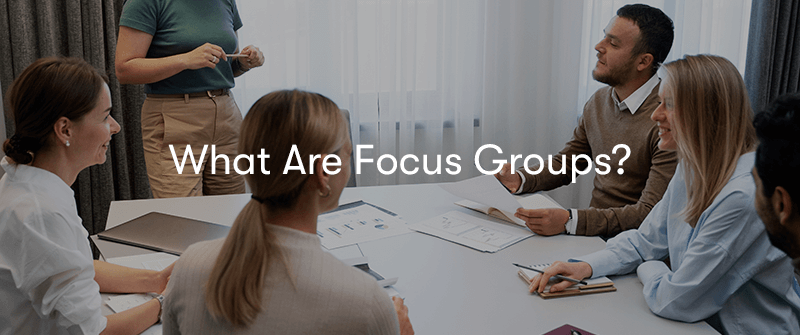What Are Focus Groups in UX Research?
In UX (User Experience) research, focus groups are invaluable tools for understanding user needs and preferences. Whether you're in the early stages of concept development or seeking to validate design choices, these carefully orchestrated sessions offer a wealth of qualitative insights. However, to ensure their success, adhere to best practices: set clear objectives, recruit diverse participants, engage skilled moderators, and foster an open and respectful environment.
Remember to record sessions, take detailed notes, and analyse the data rigorously. Armed with these insights, you can refine your designs, prioritise features, and ultimately create user-centric products and services that resonate with your target audience.
What Are Focus Groups?

Focus groups are a qualitative research method used in the field of user experience design to gather feedback and insights from a group of participants about a product, service, or digital interface. These focus groups are typically composed of a small, diverse group of users or potential users who have relevant experience or interest in the product or service being evaluated. The primary goal of a UX focus group is to understand the users' perceptions, needs, preferences, and pain points to improve the product's design and functionality.
What is UX Research?

UX research is a systematic and methodical process of gathering, analysing, and interpreting data related to users' interactions with a product, service, or system. The primary goal of UX research is to understand users' behaviours, needs, preferences, and pain points to inform and improve the design and development of user-centric solutions. UX research plays a crucial role in creating products and experiences that are intuitive, efficient, and satisfying for users.
What Are Focus Groups Used for in UX Research?

Focus groups are a valuable qualitative research method used in UX research to gather insights, opinions, and feedback from a group of participants about a product, service, or digital interface. Focus groups serve several purposes in the context of UX research:
Idea Generation and Concept Testing
Focus groups can be used to generate new ideas or concepts for a product or service. Participants discuss their needs, preferences, and pain points, which can lead to the generation of innovative design ideas. Additionally, focus groups can be used to test early concepts or design prototypes to gauge initial user reactions.
Understanding User Needs and Preferences
Focus groups help researchers better understand user needs, preferences, and expectations. Participants can articulate their goals, motivations, and the specific features or functionalities they find most important.
Exploring User Behaviour
By discussing their experiences and behaviours related to a product or service, participants can provide insights into how they currently interact with it, what tasks they perform, and any challenges they face.
Feedback on Prototypes
Focus groups are an effective way to gather feedback on early-stage prototypes or wireframes. Participants can provide input on the product's usability, functionality, and design aspects, helping identify potential issues and areas for improvement.
Content Evaluation
For products or services that involve content, such as websites, apps, or educational platforms, focus groups can assess the relevance, clarity, and organisation of the content. This feedback ensures that the content meets user needs and expectations.
Perception and Branding
Focus groups can be used to understand how users perceive a brand or product. Participants can discuss their impressions, emotions, and associations related to a product or its branding elements.
Usability and Navigation
Focus groups can help evaluate the overall usability of a product, including navigation and user interface design. Participants can identify pain points in the user journey and suggest improvements.
Comparative Analysis
Focus groups can compare different versions of a product or competing products. This helps researchers understand the strengths and weaknesses of each option from the user's perspective.
Cultural Sensitivity
In global UX research, focus groups can provide insights into cultural differences and preferences. They help ensure that products and services are culturally appropriate and relevant to specific user groups.
Generating Hypotheses
Focus group discussions can generate hypotheses and research questions for further investigation. These hypotheses can be tested through additional research methods, such as usability testing or surveys.
Stakeholder Engagement
Observing focus group sessions can engage stakeholders and decision-makers directly in the research process. Seeing real users discuss their experiences can influence strategic decisions.
Iterative Design
Focus group feedback can be used iteratively to refine product designs. After making changes based on focus group input, further rounds of testing can be conducted to validate improvements.
Problem Identification
Focus groups can uncover issues or challenges that may not have been apparent through other research methods. They can shed light on unexpected user perspectives and concerns.
In summary, focus groups in UX research are a versatile tool for gathering qualitative insights and feedback from users. They complement other research methods like surveys and usability testing, providing a well-rounded understanding of the user experience and helping design teams make informed decisions.
What Are the Advantages of Focus Groups?

UX focus groups offer several advantages in gaining insights into user experiences and perceptions. Here are some of the primary advantages of employing UX focus groups:
Diverse Perspectives
Bringing together a group of participants provides an opportunity to hear a variety of viewpoints in one session. The interaction among participants can lead to a richer understanding of user experiences and needs.
Depth of Understanding
The qualitative nature of focus groups allows for an in-depth exploration of users' feelings, attitudes, beliefs, and perceptions.
Immediate Feedback
Focus groups offer real-time feedback, enabling researchers and designers to ask follow-up questions or clarify doubts on the spot.
Dynamic Interaction
The group dynamics can lead to participants building upon each other's ideas, which may not occur in individual interviews. This synergy can reveal insights that might not emerge in a one-on-one setting.
Unanticipated Insights
The open-ended nature of focus group discussions can lead to unexpected but valuable insights. Participants may bring up topics or concerns that weren't initially on the researchers' radar.
Visual Reactions
Observing participants' non-verbal reactions to concepts, designs, or prototypes can be just as telling as their verbal feedback. Body language, facial expressions, and group dynamics provide additional layers of understanding.
Cost-Effective
While focus groups have associated costs, they can be more cost-effective than other research methods since multiple participants are engaged in a single session.
Flexibility
Focus group discussions can be adapted on the fly. If a particular topic emerges as especially significant, the moderator can choose to delve deeper into that area.
Contextual Insights
Focus groups can be tailored to specific demographics or user segments, providing contextually relevant insights. This is especially valuable when understanding niche markets or specific user groups.
Stakeholder Engagement
Observing a focus group can be enlightening for stakeholders or team members who are removed from direct user contact. Witnessing real users discuss the product can drive home the importance of user-centred design.
Validation or Refinement
If there's uncertainty about a feature or design direction, focus groups can serve as a testing ground for validation or indicate areas of refinement.
However, while UX focus groups offer numerous advantages, it's essential to balance their findings with other research methods. Focus groups have certain limitations, such as potential groupthink or dominant personalities influencing the discussion. Combining the insights from focus groups with other user research methods like usability testing, surveys, and analytics can provide a more comprehensive view of the user experience.
What Are the Disadvantages of Focus Groups?

While UX focus groups can provide valuable insights, they also have several pitfalls and limitations that researchers and designers should be aware of. Here are some common pitfalls of UX focus groups:
Small Sample Size
Focus groups typically involve a small number of participants (usually 5 to 10), which may only be representative of some of the user population. Generalising findings from a small sample can lead to inaccurate conclusions.
Groupthink
Group dynamics can sometimes lead to participants conforming to the opinions of others or not voicing dissenting views. This can result in a skewed representation of user feedback.
Dominant Participants
Some participants may dominate the discussion, drowning out the voices of quieter participants who may have valuable insights to share.
Social Desirability Bias
Participants may provide responses they believe are socially acceptable or in line with what the moderator or other participants want to hear rather than their genuine opinions.
Moderator Bias
The moderator's own biases, conscious or unconscious, can influence the direction of the discussion and the interpretation of participant responses.
Limited Context
Focus groups are conducted in a controlled environment, which may not accurately replicate the real-world context in which users interact with a product or service.
Influence of Preconceived Notions
Participants may come into the focus group with preconceived notions or expectations that can influence their feedback. For example, they may have read or heard about the product before the session.
Lack of In-Depth Insights
While focus groups provide qualitative data, they may not always provide the depth of insight needed to address complex usability or design issues. Additional research methods, such as usability testing, may be necessary for a deeper understanding.
Difficulty in Handling Sensitive Topics
Some topics or issues may be sensitive, and participants may be reluctant to openly discuss them in a group setting.
Representativeness
It can be challenging to ensure that the focus group participants are truly representative of the target user population in terms of demographics, behaviours, and preferences.
Limited Quantitative Data
Focus groups primarily yield qualitative data, making it difficult to quantify the extent of issues or preferences among users.
Resource Intensive
Planning, conducting, and analysing focus group sessions can be resource-intensive regarding time, budget, and personnel.
Difficulty in Recruitment
Finding and recruiting suitable participants who meet the criteria can be a challenge, and the sample may not always align perfectly with the user base.
To mitigate these pitfalls, it's essential to use focus groups as one component of a comprehensive UX research strategy. Combine focus group findings with other research methods like usability testing, surveys, and analytics to validate and triangulate insights. Additionally, careful planning, skilled moderation, and a well-defined research plan can help maximise the benefits of UX focus groups while minimising their limitations.
How to Conduct a Focus Group for UX Research?

Conducting successful UX focus groups requires careful planning, effective facilitation, and thoughtful analysis. Here's a step-by-step guide to help you achieve successful UX focus groups:
1. Define Your Objectives
Clearly articulate what you hope to achieve with the focus groups. Determine the specific research questions you want to address or the goals you want to accomplish.
2. Identify Your Target Audience
Define the demographics, behaviours, and characteristics of the participants who best represent your user base or target audience.
3. Recruit Participants
Use various recruitment methods, such as user databases, social media, or professional networks, to find participants who match your target audience criteria.
Over-recruit slightly to account for potential dropouts or no-shows.
4. Develop a Discussion Guide
Create a structured discussion guide that outlines the topics, questions, and activities you plan to cover during the focus group sessions.
Ensure that questions are open-ended to encourage discussion and exploration.
5. Choose a Suitable Venue
Select a comfortable, quiet, and well-lit location for the focus group sessions. Ensure that the venue is equipped with audio or video recording equipment, if necessary.
6. Prepare Materials
Gather any materials needed for the sessions, such as prototypes, wireframes, concept sketches, or product samples.
7. Select an Experienced Moderator
Choose a skilled and unbiased moderator who can guide the discussion, keep participants engaged, and ensure that the conversation remains on topic.
Train the moderator in the objectives of the study and the discussion guide.
8. Conduct Pilot Testing
Run a pilot focus group with a small group of participants who are not part of your target audience. This helps identify any issues with the discussion guide or the facilitation process.
9. Plan the Session Logistics
Arrange the schedule, ensuring that sessions are not too long (typically 1.5 to 2 hours) to maintain participant engagement.
Provide refreshments, breaks, and any necessary incentives for participants.
10. Conduct the Focus Groups
Begin each session with a brief introduction and icebreaker to create a comfortable atmosphere.
Follow the discussion guide, but be flexible to allow participants to share their insights freely.
Encourage all participants to contribute and avoid letting a single person dominate the conversation.
Use brainstorming, card sorting, or affinity mapping techniques to facilitate discussions and activities.
Record the sessions (with participant consent) to capture verbal and non-verbal feedback.
11. Analyse the Data
Transcribe and code the focus group recordings to identify key themes, patterns, and insights.
Look for both commonalities and outliers in participants' responses.
Consider using qualitative analysis software for efficient data processing.
12. Report and Share Findings
Summarise the key findings and insights in a clear, concise report.
Share the results with stakeholders, design teams, or decision-makers to inform design decisions.
13. Iterate and Take Action
Use the insights from the focus groups to make informed design changes or prioritise features.
Consider conducting additional research or usability testing to validate and refine your findings.
14. Document the Process
Keep detailed records of the entire focus group process, including recruitment, participant profiles, discussion guide, and analysis methodology. This documentation can be valuable for future reference.
15. Continuous Improvement
Use feedback from your focus group process to improve your UX research methods continuously and focus group facilitation skills.
Successful UX focus groups require careful planning, skilled moderation, and rigorous analysis. By following these steps, you can gather valuable user insights that inform your design decisions and improve the overall user experience of your product or service.
What Types of Focus Groups Can Be Useful for UX Research?

In UX research, different types of focus groups can be useful depending on the specific research goals and the stage of the design and development process. Here are several types of focus groups that can be valuable in UX research:
Exploratory Focus Groups
These focus groups are used early in the design process to explore user needs, preferences, and pain points. They are often unstructured and open-ended, allowing participants to discuss their experiences and expectations freely. Exploratory focus groups can generate ideas and insights that inform the initial design concept.
Concept Testing Focus Groups
Concept testing focus groups are used to gather feedback on early design concepts, wireframes, or prototypes. Participants provide input on the overall concept, layout, and design direction. This type of focus group helps refine and validate design ideas before investing in total development.
Usability Testing Focus Groups
Usability testing focus groups involve observing users interacting with a product or prototype. Participants complete specific tasks while researchers observe and take notes. This method helps identify usability issues, navigation problems, and areas of confusion within the user interface.
Comparative Focus Groups
Comparative focus groups involve comparing multiple design options or competing products. Participants discuss the strengths and weaknesses of each option, helping researchers understand user preferences and priorities. This type of focus group aids in making informed design decisions.
Content Evaluation Focus Groups
Content evaluation focus groups are beneficial for websites, apps, or platforms with substantial content. Participants assess the clarity, relevance, and organisation of content, helping to improve the overall user experience.
Cultural Sensitivity Focus Groups
When designing products or services for diverse user groups or global markets, cultural sensitivity focus groups can provide insights into cultural differences and preferences. They ensure that the product aligns with the cultural expectations of specific user segments.
Accessibility Focus Groups
Accessibility focus groups involve participants with disabilities, such as visual impairments or motor disabilities. These groups provide feedback on the accessibility features of a product, ensuring that it is usable by a wide range of users.
Persona Validation Focus Groups
After developing user personas based on research, persona validation focus groups can be conducted to assess whether the personas accurately represent the target audience's needs, goals, and behaviours.
Feedback and Iteration Focus Groups
Once design changes have been implemented based on previous focus group feedback, feedback and iteration focus groups can be used to validate these changes and ensure they address user concerns.
Beta Testing Focus Groups
When a product or feature is in the beta testing phase, focus groups can be organised to gather user feedback on the near-final version. This feedback helps fine-tune the product before its official release.
Remote or Online Focus Groups
In situations where in-person meetings are not feasible, remote or online focus groups can be conducted using video conferencing tools or online collaboration platforms. This approach allows researchers to gather insights from participants located in different geographic locations.
Post-Launch Feedback Focus Groups
After launching a product, focus groups can continue to provide valuable insights for ongoing improvements and updates. These sessions can help identify long-term user needs and emerging issues.
The choice of focus group type depends on the specific research objectives, the product or service being studied, and the stage of the design and development process. UX researchers often combine these focus group types as part of a comprehensive research strategy to gather insights and make informed design decisions.
What Are Some Best Practices for Focus Groups?

Effective focus groups require careful planning, skilled facilitation, and attention to various best practices. Here are some key best practices for conducting focus groups in UX research:
Clearly Define Objectives
Start by defining clear and specific research objectives. Understand what you want to learn or achieve through the focus group sessions.
Recruit Diverse Participants
Select participants who represent your target user demographics, behaviours, and characteristics. Ensure diversity to capture a range of perspectives.
Pre-Screen Participants
Screen participants in advance to ensure they meet the criteria for the study. This helps avoid any surprises during the session and ensures that participants are relevant to the research objectives.
Prepare a Discussion Guide
Develop a structured discussion guide that outlines the topics, questions, and activities to be covered during the focus group. Ensure that questions are open-ended and designed to encourage discussion.
Choose an Appropriate Venue
Select a comfortable, quiet, and well-lit venue for in-person sessions. For remote or online focus groups, ensure the chosen technology platform is user-friendly and reliable.
Use Skilled Moderators
Experienced and unbiased moderators are critical to the success of focus groups. Moderators should be skilled in guiding discussions, probing for insights, and managing group dynamics.
Establish Ground Rules
Set ground rules at the beginning of the session, including guidelines for respectful and constructive participation. Emphasise the importance of honest feedback.
Start with Icebreakers
Begin each session with icebreaker activities or introductions to create a relaxed and comfortable atmosphere among participants.
Encourage Equal Participation
Ensure that all participants have an opportunity to contribute. Encourage quieter participants to share their thoughts and discourage dominant participants from monopolising the conversation.
Use Varied Techniques
Incorporate various techniques, such as brainstorming, card sorting, or role-playing, to facilitate discussions and activities that align with your research objectives.
Observe Non-Verbal Cues
Pay attention to participants' non-verbal cues, including body language, facial expressions, and gestures. These cues can provide valuable insights.
Record Sessions
With participant consent, record audio or video of the sessions. This allows you to review the discussions and capture details that may be missed during live sessions.
Minimise Bias
Avoid leading questions or making assumptions in your discussion guide. Be aware of your biases as a moderator and strive to remain neutral.
Manage Time Effectively
Stick to the schedule and ensure that each topic or question is addressed within the allotted time. Allocate time for participant introductions, discussions, and debriefing.
Take Detailed Notes
Have a note-taker present to record key insights, quotes, and observations during the session. These notes will be essential for analysis.
Maintain Confidentiality
Ensure that participants' identities and responses are kept confidential unless they explicitly agree to be identified.
Debrief and Thank Participants
After the session, take a few minutes to debrief with participants and thank them for their time and contributions.
Data Analysis
Analyse the data collected from the focus groups systematically. Consider using qualitative analysis software for efficient data processing and coding.
Share Findings
Summarise the key findings and insights in a report. Share the results with stakeholders, design teams, or decision-makers to inform design decisions.
Iterate and Take Action
Use the insights from the focus groups to make informed design changes or prioritise features. Consider conducting additional research to validate and refine findings.
By following these best practices, you can maximise the effectiveness of your focus group sessions and gather valuable user insights to inform your UX research and design efforts.
Where Can You Learn More About UX Design?
Our BCS Foundation Certificate in User Experience training course is perfect for anyone who wants to increase their knowledge of User Experience. The BCS User Experience course will teach you the UX methodology, best practices, techniques, and a strategy for creating a successful user experience. The course will cover the following topics:
- Guiding Principles
- User Research
- Illustrating The Context of Use
- Measuring Usability
- Information Architecture
- Interaction Design
- Visual Design
- User Interface Prototyping
- Usability Evaluation
Click the button below to find out more.

Final Notes on Focus Groups for UX Research
In UX research, focus groups serve as invaluable tools for understanding user needs and preferences. Whether you're in the early stages of concept development or seeking to validate design choices, these carefully orchestrated sessions offer a wealth of qualitative insights.
However, to ensure their success, adhere to best practices: set clear objectives, recruit diverse participants, engage skilled moderators, and foster an open and respectful environment. Remember to record sessions, take detailed notes, and analyse the data rigorously. Armed with these insights, you can refine your designs, prioritise features, and ultimately create user-centric products and services that resonate with your target audience.



